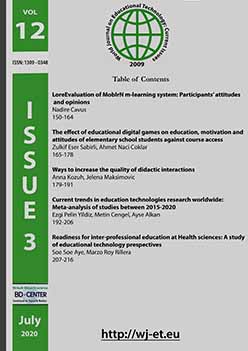Readiness for inter-professional education at Health sciences: A study of educational technology prespectives
Readiness for inter-professional education at Health sciences: A study of educational technology prespectives
Author(s): Soe Soe Aye, Marzo Roy RilleraSubject(s): Education, Health and medicine and law
Published by: Birlesik Dunya Yenilik Arastirma ve Yayincilik Merkezi
Keywords: four dimensional curriculum; inter-professional education; inter-professional learning; medical education;
Summary/Abstract: Background: Interprofessional Education (IPE), provides an integrative and rewarding learning platform for different healthcare professions to engage with each other in a cooperative basis to ultimately improve healthcare services for patients. Throughout the years, IPE has established itself as an indispensible tool in cultivating the necessary skills, mindset, and understanding to enhance interprofessional collaboration among healthcare providers. That being said, as with many other educational approaches, the success of IPE hinges on the readiness of healthcare professions students to learn and apply the concept; and yet, despite having been readily explored in numerous Western institutions, such readiness among healthcare students in Asian universities remains largely unknown. Methods: We measured attitudes related to interprofessional education & collaboration using a questionnaire called Readiness for Interprofessional Learning Scale (RIPLS). A total of 158 students from three faculties of health sciences at Asia Metropolitan University participated in this study. Cumulative result, as well as results from individual faculties were analyzed using Descriptive and non-parametric statistics. Results: Medical students overall, reported a higher rating for the perceived benefits of working together to solve patient problems compared to other students from other health sciences faculties. They are more receptive to working with other students from different healthcare professions in small-team projects and also seem to value the importance of mutual learning when dealing with patients’ problems. On the other hand,nursing students were more uncertain of how they will fit into a cross-disciplinary team in a professional capacity and felt the need to acquire much more knowledge and skills when compared to students from other health sciences faculties. The total RIPLSscore among all three faculties of health sciences at Asia Metropolitan University was in the high range.Conclusion: Students from three faculties of health sciences offered at Asia Metropolitan University namely Faculty of Medicine,Faculty of Healthcare Management, and Faculty of Nursing, were deemed IPE ready. Recommendations: The university needs to consider how to integrate IPE into the curricula, define learning outcomes and/ or competencies, develop and utilize the 4-dimensional curriculum development blueprint in line with health professional accreditation standards to promote collaboration and competence among all students ,whereby upon graduation, they as healthcare professionals, will in turn, optimize health services, strengthen health systems, and improve health outcomes.
Journal: World Journal on Educational Technology: Current Issues
- Issue Year: 12/2020
- Issue No: 3
- Page Range: 207-216
- Page Count: 10
- Language: English

